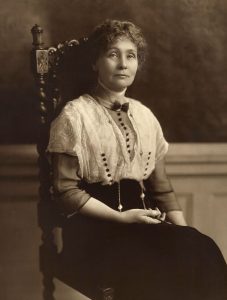Women’s Franchise League (1889-1903)
“The League appeals to women of all parties absolutely to refuse to work for any candidate who declines to grant to them the parliamentary vote.” – Manifesto of the Women’s Franchise League, 1895
In 1889, Emmeline Pankhurst (1858-1928) and her husband Richard Pankhurst (1825-1898), an attorney, founded the Women’s Franchise League (WFL). This organization was one of the first middle-class organizations to promote women’s suffrage in nineteenth-century Britain. The main goal of the WFL was to advocate for married women’s the right to vote in local elections. The organization was active until 1903, five years after Richard Pankhurst’s death, yet its dissolution nowhere near ended the Pankhurst family’s involvement in the women’s suffrage movement.
The Pankhurst family was a major force in the British women’s suffrage movement. Their creation of the Women’s Franchise League was one of the first organizations they founded. Prior to the founding of the Women’s Franchise League, Emmeline and her sister participated in a feminist demonstration during the 1868 General Election and in 1872 she attended the first of many suffragist meetings. Richard Pankhurst also was involved early on in supporting women’s suffrage. He drafted the Municipal Franchise Act of 1869. This legislation extended the vote to women rate-payers in local elections. The act also enabled women to serve as Poor Law Guardians. Several suffragists, including Marie Corbett, Emmeline Pankhurst and Charlotte Despard took this opportunity to become involved in local government. Pankhurst also drafted the Married Women’s Property Act, passed in 1870, that allowed married women to be legal owners of their earned and inherited property.
In 1889, Emmeline and Richard Pankhurst created the Women’s Franchise League and dedicated it primarily to gaining that right to vote for women on the local level. The history of this organization illustrates the radicalization of Emmeline Pankhurst’s beliefs regarding women’s suffrage. She began advocating with her husband for local suffrage through the Women’s Franchise League, but it proved to be only a stepping stone for her to become a major figurehead of the more radical movement for all women’s right to vote on the same grounds as men in the national level. She wanted the voting rules for men to be extended to women. When this was not achieved through peaceful campaign strategies, she began to see the necessity of using more militant strategies. The founding of the Women’s Franchise League would prove the least radical of all of her feminist endeavors. However, in some ways because of this, it also provided her the credibility she would need to become the leading organizer of the militant women’s suffrage movement.
The Women’s Franchise League was not the most successful of the organizations that Emmeline Pankhurst helped found. However, it was a crucial step for her to gain experience as a leader for women’s suffrage. The organization also opened the doors for middle-class women to become involved early on in the suffragist movement. Lesser known groups, such as the Women’s Franchise League, were just as important as larger groups because they provided a segue into the larger, more efficient organizations that we remember.
Shana Loudermelk, History and Psychology double major, Class of 2019
Sources
Literature and Websites
- Daniels, Patricia, and Contributing Writer. “A Closer Look at Women’s Rights Activist Emmeline Pankhurst.” ThoughtCo, at: https://www.thoughtco.com/emmeline-pankhurst-1779832. (Accessed April 22, 2018).
- Simkin, John. “Emmeline Pankhurst.” Spartacus Educational, September 1997, at: http://spartacus-educational.com/WpankhurstE.htm. (Accessed April 22, 2018).
- Simkin, John. “Richard Pankhurst.” Spartacus Educational, August 2014. http://spartacus-educational.com/TUpankhurst.htm. (Accessed April 22, 2018).


